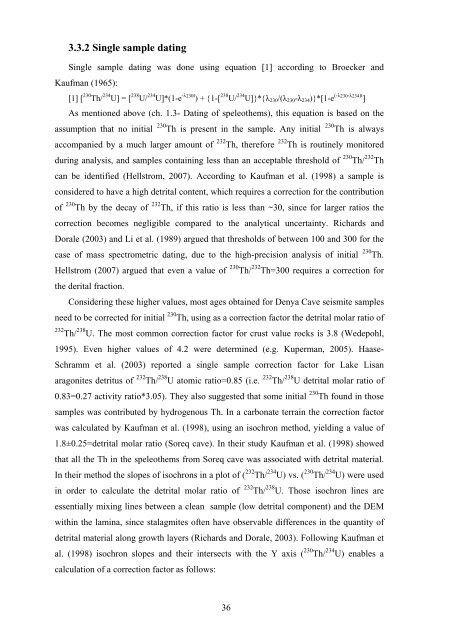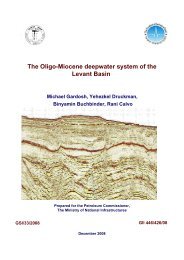tivity on the carmel faul
tivity on the carmel faul
tivity on the carmel faul
You also want an ePaper? Increase the reach of your titles
YUMPU automatically turns print PDFs into web optimized ePapers that Google loves.
3.3.2 Single sample dating<br />
Single sample dating was d<strong>on</strong>e using equati<strong>on</strong> [1] according to Broecker and<br />
Kaufman (1965):<br />
[1] [ 230 Th/ 234 U] = [ 238 U/ 234 U]*(1-e -λ230t ) + {1-[ 238 U/ 234 U]}*{λ 230 /(λ 230 -λ 234 )}*[1-e (-λ230-λ234)t ]<br />
As menti<strong>on</strong>ed above (ch. 1.3- Dating of speleo<strong>the</strong>ms), this equati<strong>on</strong> is based <strong>on</strong> <strong>the</strong><br />
assumpti<strong>on</strong> that no initial 230 Th is present in <strong>the</strong> sample. Any initial 230 Th is always<br />
accompanied by a much larger amount of 232 Th, <strong>the</strong>refore 232 Th is routinely m<strong>on</strong>itored<br />
during analysis, and samples c<strong>on</strong>taining less than an acceptable threshold of 230 Th/ 232 Th<br />
can be identified (Hellstrom, 2007). According to Kaufman et al. (1998) a sample is<br />
c<strong>on</strong>sidered to have a high detrital c<strong>on</strong>tent, which requires a correcti<strong>on</strong> for <strong>the</strong> c<strong>on</strong>tributi<strong>on</strong><br />
of 230 Th by <strong>the</strong> decay of 232 Th, if this ratio is less than ~30, since for larger ratios <strong>the</strong><br />
correcti<strong>on</strong> becomes negligible compared to <strong>the</strong> analytical uncertainty. Richards and<br />
Dorale (2003) and Li et al. (1989) argued that thresholds of between 100 and 300 for <strong>the</strong><br />
case of mass spectrometric dating, due to <strong>the</strong> high-precisi<strong>on</strong> analysis of initial 230 Th.<br />
Hellstrom (2007) argued that even a value of 230 Th/ 232 Th=300 requires a correcti<strong>on</strong> for<br />
<strong>the</strong> derital fracti<strong>on</strong>.<br />
C<strong>on</strong>sidering <strong>the</strong>se higher values, most ages obtained for Denya Cave seismite samples<br />
need to be corrected for initial 230 Th, using as a correcti<strong>on</strong> factor <strong>the</strong> detrital molar ratio of<br />
232 Th/ 238 U. The most comm<strong>on</strong> correcti<strong>on</strong> factor for crust value rocks is 3.8 (Wedepohl,<br />
1995). Even higher values of 4.2 were determined (e.g. Kuperman, 2005). Haase-<br />
Schramm et al. (2003) reported a single sample correcti<strong>on</strong> factor for Lake Lisan<br />
arag<strong>on</strong>ites detritus of 232 Th/ 238 U atomic ratio=0.85 (i.e. 232 Th/ 238 U detrital molar ratio of<br />
0.83=0.27 ac<str<strong>on</strong>g>tivity</str<strong>on</strong>g> ratio*3.05). They also suggested that some initial 230 Th found in those<br />
samples was c<strong>on</strong>tributed by hydrogenous Th. In a carb<strong>on</strong>ate terrain <strong>the</strong> correcti<strong>on</strong> factor<br />
was calculated by Kaufman et al. (1998), using an isochr<strong>on</strong> method, yielding a value of<br />
1.8±0.25=detrital molar ratio (Soreq cave). In <strong>the</strong>ir study Kaufman et al. (1998) showed<br />
that all <strong>the</strong> Th in <strong>the</strong> speleo<strong>the</strong>ms from Soreq cave was associated with detrital material.<br />
In <strong>the</strong>ir method <strong>the</strong> slopes of isochr<strong>on</strong>s in a plot of ( 232 Th/ 234 U) vs. ( 230 Th/ 234 U) were used<br />
in order to calculate <strong>the</strong> detrital molar ratio of 232 Th/ 238 U. Those isochr<strong>on</strong> lines are<br />
essentially mixing lines between a clean sample (low detrital comp<strong>on</strong>ent) and <strong>the</strong> DEM<br />
within <strong>the</strong> lamina, since stalagmites often have observable differences in <strong>the</strong> quantity of<br />
detrital material al<strong>on</strong>g growth layers (Richards and Dorale, 2003). Following Kaufman et<br />
al. (1998) isochr<strong>on</strong> slopes and <strong>the</strong>ir intersects with <strong>the</strong> Y axis ( 230 Th/ 234 U) enables a<br />
calculati<strong>on</strong> of a correcti<strong>on</strong> factor as follows:<br />
36

















